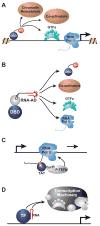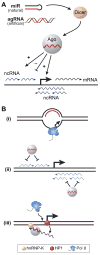Riboactivators: transcription activation by noncoding RNA
- PMID: 19280431
- PMCID: PMC2749515
- DOI: 10.1080/10409230902734044
Riboactivators: transcription activation by noncoding RNA
Abstract
The paradigm of gene regulation was forever changed by the discovery that short RNA duplexes could directly regulate gene expression. Most regulatory roles attributed to noncoding RNA were often repressive. Recent observations are beginning to reveal that duplex RNA molecules can stimulate gene transcription. These RNA activators employ a wide array of mechanisms to up-regulate transcription of target genes, including functioning as DNA-tethered activation domains, as coactivators and modulators of general transcriptional machinery, and as regulators of other noncoding transcripts. The discoveries over the past few years defy "Moore's law" in the breath-taking rapidity with which new roles for noncoding RNA in gene expression are being revealed. As gene regulatory networks are reconstructed to accommodate the influence of noncoding RNAs, their importance in maintenance of cellular health will become increasingly apparent. In fact, a new generation of therapeutic agents will focus on modulating the function of noncoding RNA.
Figures




References
Publication types
MeSH terms
Substances
Grants and funding
LinkOut - more resources
Full Text Sources
Other Literature Sources
Research Materials
Miscellaneous
